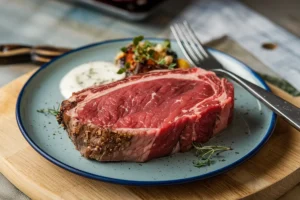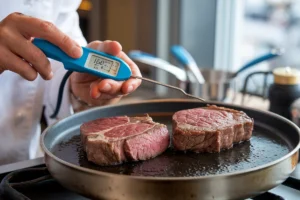Cooking steak bites to perfection can be an art. Whether you like them rare, medium, or well-done, the key is knowing how to get them just right. Overcooking results in a dry and chewy texture, while undercooking can be unsafe or unappetizing for many. So, how do you know when steak bites are cooked?
In this article, we’ll explore the various techniques, tips, and tricks to ensure you always know when your steak bites are ready to eat. From visual cues and temperature checks to advanced methods and common mistakes, you’ll learn everything you need to cook steak bites like a pro.
Why It’s Important to Know When Steak Bites Are Cooked
Knowing how to know when steak bites are cooked is essential for both health and flavor. Ensuring the steak bites reach the right internal temperature guarantees that they are safe to eat and delicious. Learn how to achieve perfect doneness by following these tips.
- Health and safety: Undercooked steak may harbor harmful bacteria such as E. coli or Salmonella, which can cause foodborne illnesses. According to the USDA Steak Doneness Guide, steak needs to reach a minimum internal temperature of 145°F (63°C) for safety.
- Texture and flavor: Steak cooked at the right level of doneness retains its juiciness and tenderness. Overcooking will dry it out, while undercooking can leave it too raw or chewy.
- Aesthetic appeal: Steak bites that are properly cooked have a beautiful brown crust, achieved through the Maillard reaction, while the interior remains juicy and flavorful.
Let’s dive into the techniques you can use to make sure your steak bites are always cooked to perfection.
How to Use Temperature to Determine Doneness
The most reliable method for how to know when steak bites are cooked is to check their internal temperature. According to the USDA, different doneness levels require specific temperatures. Here are the steps and temperatures you need to follow:
USDA Recommended Internal Temperatures for Steak Bites:
- Rare: 125°F (52°C)
- Medium-rare: 135°F (57°C)
- Medium: 145°F (63°C)
- Medium-well: 150°F (66°C)
- Well-done: 160°F (71°C)
Using an instant-read thermometer can make this process easy. Simply insert the thermometer into the thickest part of a steak bite, making sure not to touch any bone or pan. If you’re unsure about the thermometer to use, this Instant-Read Thermometer Guide offers detailed advice.
Advantages of Using Temperature for Steak Doneness:
- Accuracy: Ensures steak bites are neither overcooked nor undercooked.
- Safety: Especially important when serving others or preparing steak bites for children or pregnant women.
- Consistency: With practice, you’ll achieve your preferred level of doneness every time.
However, it’s not just about temperature. Other methods, like visual cues and touch tests, can also give you a good indication of doneness.
Visual Cues for Cooking Steak Bites
If you don’t have a thermometer handy, you can use visual cues to gauge whether your steak bites are cooked. Here’s what to look for at each level of doneness:
- Rare: The steak will have a very red center, with a cool interior and juices pooling slightly on the surface.
- Medium-rare: The center will still be red, but warmer, with pink juices.
- Medium: The center will be mostly pink with only a hint of red. The outside should be seared brown.
- Well-done: The interior will be gray-brown, with no pink, and very little moisture will seep out when cut.
You can also use the slit test, which involves cutting open one piece of steak to check the color inside. This can be a quick and easy way to determine doneness, but be cautious, as it may lead to overcooking if done too early in the process.
The Touch Test for Steak Bites
The touch test is another quick method to check if your steak bites are done. It involves comparing the feel of the steak with different parts of your face:
- Rare: The steak feels soft and spongy, like the feel of your cheek.
- Medium-rare: The steak gives slight resistance when pressed, similar to the feeling of your chin.
- Medium: The steak feels firm but still has some give, much like the firmness of your forehead.
- Well-done: The steak is very firm and unyielding, similar to pressing down on the tip of your nose.
Using this method can take some practice, but over time, you’ll be able to judge doneness by feel with great accuracy.
Cooking Time Guide for Steak Bites
While temperature, touch, and visual cues are all excellent ways to check doneness, knowing how long to cook steak bites based on their thickness and desired doneness is also important. Here’s a general guide:
Pan-Searing Steak Bites:
- Rare: Cook for 1-2 minutes per side.
- Medium-rare: Cook for 2-3 minutes per side.
- Medium: Cook for 3-4 minutes per side.
- Well-done: Cook for 4-5 minutes per side.
Grilling Steak Bites:
- Rare: Grill for 1-2 minutes per side.
- Medium-rare: Grill for 2-3 minutes per side.
- Medium: Grill for 3-4 minutes per side.
- Well-done: Grill for 4-6 minutes per side.
Oven-Baking Steak Bites:
If you’re baking the steak bites in the oven, cook them at 400°F (200°C) for:
- Medium-rare: 6-8 minutes.
- Medium: 8-10 minutes.
- Well-done: 10-12 minutes.
Adjust the times slightly depending on the size of the steak bites and how much doneness you prefer.
Letting Steak Bites Rest: The Secret to Juiciness
After you’ve cooked your steak bites, it’s essential to let them rest for a few minutes before serving. Resting helps the juices redistribute throughout the meat, making your steak bites juicier and more flavorful.
Here’s how to do it:
- Remove the steak bites from the heat and place them on a cutting board or plate.
- Cover loosely with aluminum foil and let rest for 5-7 minutes.
If you’re wondering why this step is crucial, the Serious Eats Guide to Resting Steak provides an excellent explanation.
Common Mistakes When Cooking Steak Bites (And How to Avoid Them)
While cooking steak bites may seem simple, there are several common mistakes that can affect the quality of the final dish. Here’s how to avoid them:
1. Overcooking or Undercooking:
Cooking steak bites too long can lead to a tough texture, while undercooking might leave the center raw. Always use the right cooking method and refer to the internal temperature to get them just right.
2. Not Letting the Steak Rest:
Skipping the resting step can result in dry, flavorless steak bites. As mentioned earlier, allowing your steak to rest will redistribute the juices, resulting in a more tender bite.
3. Cooking at the Wrong Temperature:
Searing steak bites on high heat can create a beautifully browned crust, but if the heat is too high, the outside can burn while the inside remains raw. Use medium to high heat and control the cooking process for optimal results.
4. Using the Wrong Cut of Meat:
Not all steak cuts are ideal for steak bites. The best options are sirloin, ribeye, or tenderloin, which offer a balance of flavor, tenderness, and juiciness.
Advanced Techniques for Perfect Steak Bites
Once you’ve mastered the basics, you can experiment with advanced cooking techniques to elevate your steak bites to the next level:
Reverse Searing:
In this method, you slowly cook the steak bites at a low temperature (in the oven or sous vide), then finish by searing them in a hot pan. This gives you more control over the doneness and creates a perfect crust.
Butter-Basting:
Basting your steak bites with garlic butter during the last minute of cooking adds an extra layer of flavor and richness. Simply add butter and garlic to the pan and spoon the melted mixture over the steak bites.
Cast-Iron Cooking:
Using a cast-iron skillet for cooking steak bites can enhance the sear and lock in juices. Cast iron retains heat better than non-stick pans, allowing for even browning.
FAQs: Frequently Asked Questions About Steak Bites
1. How Do I Know When Steak Bites Are Done Without a Thermometer?
You can use the touch test or visual cues like the color of the steak’s interior and the juices it releases. Cutting one piece open (the slit test) can also help determine doneness.
2. Can I Cook Steak Bites in the Oven Only?
Yes, you can cook steak bites entirely in the oven. Preheat to 400°F (200°C), season the steak, and bake for 6-12 minutes depending on your desired level of doneness.
3. What’s the Best Steak Cut for Steak Bites?
Sirloin, ribeye, and tenderloin are the best cuts for steak bites, offering a balance of flavor and tenderness.
4. Can I Freeze Cooked Steak Bites, and How Do I Reheat Them?
Yes, you can freeze cooked steak bites. Place them in an airtight container, freeze for up to 3 months, and reheat gently on the stovetop or in the oven to avoid drying them out.
5. Should I Cut Steak Bites Before or After Cooking?
It’s generally best to cut steak into bite-sized pieces after cooking to prevent losing too much moisture. However, if you prefer, you can cut them before cooking, especially if you’re pan-searing.
Conclusion: Mastering the Art of Cooking Steak Bites
Knowing when steak bites are cooked is a matter of practice, technique, and patience. By using a combination of temperature, touch, and visual cues, you can ensure your steak bites are always perfectly cooked to your preferred doneness. Don’t forget to experiment with different seasonings and cooking methods, and always let your steak rest for the best results.
With these tips and techniques, you’re well on your way to mastering the art of cooking steak bites and impressing your family and friends at every meal.



